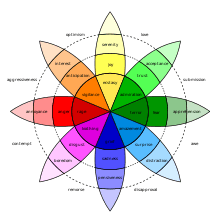Hysteria
Hysteria colloquially means ungovernable emotional excess.[1] Generally, modern medical professionals have abandoned using the term "hysteria" to denote a diagnostic category, replacing it with more precisely defined categories, such as somatization disorder.[2] In 1980, the American Psychiatric Association split phenomenology previously captured by the "hysteria" construct into discrete chapters on conversion, somatization, and dissociative disorders.
| Part of a series on |
| Emotions |
|---|
  |
|
Origin
While the word hysteria originates from the Greek word for uterus, hystera (ὑστέρα), the word itself is not an ancient one, and the term "hysterical suffocation" – meaning a feeling of heat and inability to breathe, was instead used in ancient Greek medicine. The Greeks believed that the uterus moves through a woman's body, eventually strangling her and inducing disease.[3] This suggests an entirely physical cause for the symptoms but, by linking them to the uterus, suggests that the disorder can only be found in women.[4]
Historically, hysteria was thought to manifest itself in women (female hysteria) with a variety of symptoms, including: anxiety, shortness of breath, fainting, insomnia, irritability, nervousness, as well as sexually forward behaviour.[5] These symptoms mimic symptoms of other more definable diseases and create a case for arguing against the validity of hysteria as an actual disease, and it is often implied that it is an umbrella term for an indefinable illness.[4] One of the early definitive works on hysteria was Paul Briquet's study involving 400 hysterical patients from 1849 to 1859.[6]
Modern concept
Through the 20th century, the label hysteria was applied to a mental, rather than uterine or physical, affliction.[7]
In modern usage, the term hysteria connotes mass panic (mass hysteria). Hysteria was often associated with events such as the Salem witch trials.
The term hysterical, applied to an individual, can mean that they are emotional or irrationally upset; applied to a situation that does not involve panic, it means that situation is uncontrollably amusing (the connotation being that it invokes hysterical laughter).
See also
- Borderline personality disorder
- Histrionic personality disorder
- Hysterical contagion
- Body-centred countertransference
- Scotomization
- Somatization disorder
- Female hysteria
- Male hysteria
- Wandering womb
References
- Beattie, Michael; Lenihan, Penny (2018). Counselling Skills for Working with Gender Diversity and Identity. London: Jessica Kingsley Publishers. p. 83. ISBN 9781785927416.
- Adams, Henry (1984). Comprehensive Handbook of Psychopathology. New York: Springer Science+Business Media. p. 319. ISBN 9781461566830.
- O'Brien, Jodi (2009). Encyclopedia of Gender and Society. Thousand Oaks, CA: SAGE. p. 448. ISBN 9781412909167.
- Gilman, Sander L.; King, Helen; Porter, Roy; Rousseau, G.S.; Showalter, Elaine (1993). Hysteria Beyond Freud. Los Angeles: University of California Press.
- Maines, Rachel (1999). The technology of Orgasm: 'Hysteria', the Vibrator, and Women's Sexual Satisfaction. Baltimore: The Johns Hopkins University Press.
- Lamberty, Greg (2008). Understanding Somatization in the Practice of Clinical Neuropsychology. Oxford: Oxford University Press. p. 5. ISBN 9780195328271.
- Carta, Mauro Giovanni; Fadda, Bianca; Rappeti, Mariangela; Tasca, Cecilia (October 19, 2012). "Women and Hysteria In Mental Health". Clin Pract Epidemiol Ment Health. 8: 110–19. doi:10.2174/1745017901208010110. PMC 3480686. PMID 23115576.
- Gilman, Sander L., Helen King, Roy Porter, G.S. Rousseau and Elaine Showalter. Hysteria Beyond Freud. Los Angeles University of California Press, 1993.
- Devereux, Cecily. "Hysteria, Feminism, and Gender Revisited: The Case of the Second Wave". University of Alberta
- Carta, Mauro Giovanni, Bianca Fadda, Mariangela Rappeti and Cecilia Tasca. "Women and Hysteria In Mental Health". Clin Pract Epidemiol Ment Health. 2012; 8: 110–19.
Further reading
- Paul Briquet (1859). Traité clinique et thérapeutique de l’Hystérie from Gallica at BnF
- Chodoff, P. et al. (1982) Hysteria, John Wiley & Sons.
- Halligan, P.W., Bass, C., & Marshall, J.C. (Eds.) (2001) Contemporary Approach to the Study of Hysteria: Clinical and Theoretical Perspectives, Oxford University Press
- Hennefeld, Maggie (December 2016). "Death from Laughter, Female Hysteria, and Early Cinema". differences: A Journal of Feminist Cultural Studies. Duke University Press. 27 (3): 45–92. doi:10.1215/10407391-3696631.CS1 maint: ref=harv (link)
- Sander Gilman, Roy Porter, George Rousseau, Elaine Showalter, and Helen King (1993). Hysteria Beyond Freud, University of California Press
- Andrew Scull (2009) Hysteria. The Biography, Oxford University Press
External links
| Classification |
|---|
- Is Hysteria Real? Brain Images Say Yes at the New York Times.
- The H-Word, Guardian Unlimited, 2002-09-02
- Hysteria, BBC Radio 4 discussion with Juliet Mitchell, Rachel Bowlby & Brett Kahr (In Our Time, Apr. 22, 2004)